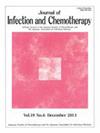Fully automated identification of Neisseria meningitidis using the BD MAX system in a clinical laboratory setting: A preliminary study
IF 1.9
4区 医学
Q3 INFECTIOUS DISEASES
引用次数: 0
Abstract
The rapid and accurate identification of Neisseria meningitidis, a pathogen that causes invasive infections and meningitis, is crucial for its effective clinical management and infection control. However, identification using matrix-assisted laser desorption/ionization time-of-flight mass spectrometry may misidentify other Neisseria species as N. meningitidis, thus necessitating confirmatory tests based on biochemical properties. These tests require high bacterial concentrations that are achieved through subculturing, which can increase biosafety risks in laboratories.
In this study, we developed a real-time polymerase chain reaction detection system for N. meningitidis using the BD MAX automated genetic testing platform. We then evaluated its accuracy using 25 strains of clinically isolated Neisseria species, including N. meningitidis. Our detection results were in full agreement with those of sequencing-based identification, with a minimum detection sensitivity of 10 CFU/mL. The BD MAX system completes all measurements in a closed system, allowing for the rapid and precise identification of N. meningitidis while reducing laboratory biosafety risks.
求助全文
约1分钟内获得全文
求助全文
来源期刊

Journal of Infection and Chemotherapy
INFECTIOUS DISEASES-PHARMACOLOGY & PHARMACY
CiteScore
4.10
自引率
4.50%
发文量
303
审稿时长
47 days
期刊介绍:
The Journal of Infection and Chemotherapy (JIC) — official journal of the Japanese Society of Chemotherapy and The Japanese Association for Infectious Diseases — welcomes original papers, laboratory or clinical, as well as case reports, notes, committee reports, surveillance and guidelines from all parts of the world on all aspects of chemotherapy, covering the pathogenesis, diagnosis, treatment, and control of infection, including treatment with anticancer drugs. Experimental studies on animal models and pharmacokinetics, and reports on epidemiology and clinical trials are particularly welcome.
 求助内容:
求助内容: 应助结果提醒方式:
应助结果提醒方式:


